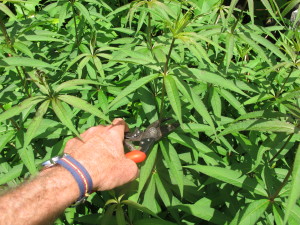Pinching? This Isn’t Kindergarten!
I was presenting at an outdoor gardening event recently when a woman walked by wearing a tee shirt that said, “No Pinching!” Maybe she had young kids, or was a kindergarten teacher. Clearly she was not an experienced gardener. Pinching plants is good, and now is the time to do it.
Let’s start with fruit trees. Many apple trees are loaded with small fruit now. Often there are 5 or more fruits together, especially at the tips of branches. If you pick off all but one or two fruits now, they will grow to a nice size. If you leave all the fruit on the tree, each fruit will be smaller. Not only that, you can often see what fruit is already damaged by insects and disease; it is smaller, and discolored. Removing that fruit will help the fruit you leave to be healthier. And eventually, you have to pick all the fruit anyway. It’s easier to do it now than in the fall. Leave the biggest, best looking fruit.
To thin fruit now, hold the cluster of small fruits in one hand, and pinch them off with the other. Holding the cluster helps to avoid breaking off the fruit spur and all the fruit on it. You can use pruning shears, but it is faster just to pinch (or pull) off the fruit. Don’t throw the fruit on the ground; it may be diseased or harbor insect pests, so you want to get rid of it. Come with plastic buckets and place them strategically around the tree as you work.
Work your way up the branch. Leave an apple or two every 8 inches. Michael Phillips, the author of two excellent books on growing organic apples, explains The Apple Grower: A Guide for in the Organic Orchardist (Chelsea Green Publishing, $40) that it is good to take all apples on alternating fruit spurs. This promotes a good harvest every year instead of a big harvest every other year, which is common on some varieties of trees. And remember, as you lament pulling off potential pies, that there is a limit to how many apples most of us can use.
I recently pinched off a bucket of blossoms from that terrible invasive weed known as goutweed or Bishops’s weed (Aegopodium podagraria). I have come to accept that I will never rid myself of this noxious pest, but I do believe I can limit its spread. It spreads quickly by root, which I limit with a lawnmower and some pulling. Seeds? From a reading of the literature, that they do not appear to be a primary means of dispersal. Still, in 15 minutes I can rid myself of the seeds, so I do. No point in taking chances.
When picking the goutweed flower heads, I ended up using my pruners, because with each flower, there is usually a lower, secondary flower cluster that is still developing under the shade of the leaves. I want to get both, so I reach down and snip off the stem lower down. Instead of tossing the flowers in the compost, I put them in the household trash that will go to the incinerator. A fitting demise for a devilish plant.
Annual flowers are coming in to bloom now, and pinching off spent flowers is important. I have some nice purple verbena growing in a window box by the front door. I often pause for a few moments and look at it to see if there are spent flowers. There always are, and I pinch them off. This stimulates the plant to set new buds. After all, it wants to make babies – and if an herbivore or a tidy gardener has removed its seeds, it needs to make more, starting with new flowers.
Not all annuals need to have their flowers pinched off. Some are called “self-cleaning”. They drop their flowers once they have finished blooming. Impatiens, begonias, and Euphorbias like ‘Diamond Frost’ are self-cleaning. Those that do need deadheading include annual bachelor buttons, gazanias, geraniums, marigolds, osteospurmums, pansies, pincushion flowers, salvias, snapdragons, sunflowers, verbenas and zinnias.
Another June task is to pinch or cut back tall summer- of fall-blooming perennials that you wish would stay shorter or bloom later. But you must do this now, or soon. It is fine to cut back these perennials when they are starting to form buds. The stems that you cut back – I recommend cutting off 4 to 6 inches – will have smaller flowers and often instead of 1 flower per stem, may have multiple blossoms.
I have already cut back my Culver’s root (Veronicastrum virginicum) and some of my bee balm (Monarda didyma). Both respond well to it. They bloom at a shorter height. My Culver’s root, if left alone, will often flop over –it can reach 4 to 5 feet in height. I cut back stems in a ring around the perimeter of the big clump, leaving just a few at full height in the middle. The lower stems help support the taller ones, and they bloom at different times.
There is a wonderful book by Tracy DiSabato-Aust, The Well-Tended Perennial Garden (Timber Press, $34.95) that nicely explains cutting back, and lists those perennials that respond well to it – and those that do not. She recommends cutting back asters, purple cone flower, Joe Pye weed, helenium, phlox, rudbekias and more.
So go ahead and pinch something. You’ll see it’s good –despite what you may have learned in kindergarten.
Henry is the author of 4 gardening books, and a children’s chapter book about a boy and a cougar, Wobar and the Quest for the Magic Calumet. His web site is www.Gardening-Guy.com.




